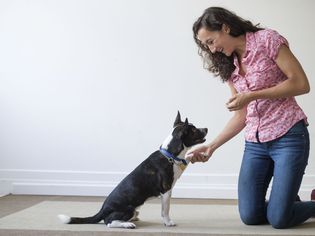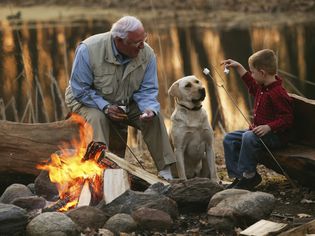How to Train an Older Dog to Do New Tricks
While most people associate training with puppies, the reality is that dogs can learn at any age. Adult dogs are often easier to train than young pupp

Are you ready to start training your dog? A proper dog training program is the cornerstone of good behavior in dogs. It has often been said that there are no bad dogs, only uneducated owners. Most dogs thrive with boundaries and predictable routines. Without obedience training, they simply do not know how to behave. Well-trained dogs are happier and healthier than untrained dogs, and so are their owners.
There are a lot of different ways to train your dog. You may choose to sign up for a dog training class, hire a professional dog trainer for private lessons, or even send your dog to board with a trainer. However, plenty of people successfully train their dogs on their own. It's a great way to save money on training costs, and a wonderful way to bond with your dog.
To effectively train your dog, you must have a plan. You will need to gather some equipment, set up a schedule, and learn a few things about training. You also need to be fully committed and prepared for a daily commitment. Here's what you need in to begin a dog obedience training program yourself.
Effective dog training does not require many items, but there are a few basic supplies that will help make the process more convenient and effective. Choose a dog collar or harness that is suitable and comfortable for your dog. Then decide which dog leash is best for training. A retractable leash is not appropriate for dog training. You will also need dog training treats that your dog enjoys and are easy to eat quickly so the reward is more immediate. There are plenty of great treats available at pet stores or you can also use something you make at home, like small pieces of plain cooked chicken or turkey.
Before you begin dog obedience training, choose the best method for you and your dog. Training styles vary, but most trainers agree that dogs respond best to positive reinforcement, such as praise or treats. One common training variation, known as clicker training, includes the use of conditioned reinforcers. There are plenty of dog training books and websites where you can learn about training techniques and determine which best suits you and your dog. When planning out your training methods, don't forget about socialization.
Success is usually attained in small steps. Training sessions with your dog should last 10 to 15 minutes, two to three times per day. This is especially true for puppies because of their very short attention spans. Longer sessions can cause an adult dog to become bored. Start by teaching basic commands. Try to stick with one action per training session so your dog does not get confused.
Often, the sit command will be one of the easiest for your dog to learn first. Next, you can train your dog to lie down. At the same time, work on teaching your dog to stay. In addition, your dog should be trained to come when called as soon as possible. This is one of the most important fundamental commands. Once your dog has mastered these dog obedience basics, you can move on to fun tricks and advanced commands.
Seeking professional help doesn't mean ditching your DIY training program. You can find a professional dog trainer who offers private training sessions, and some trainers even offer online sessions. Many dog owners prefer to join a local dog obedience class so they will be under the supervision of a dog training instructor without the higher cost of private sessions. Plus, classes challenge your dog to focus despite the distractions of other dogs.
Dog training classes or private sessions can also be an addition to your own training program. The dog trainer can help you improve the program and customize it to your dog's learning style. Try to be as involved as possible when it comes to your dog's training. You and your dog will be a stronger team when you are directly involved in the training process.
Dog training takes time, and you and your dog are likely to hit a few bumps along the way. You may see some resistance or stubborn behavior. Keep things positive, reward your dog for good behavior, and make sure you use a reward your dog will work for.
You may also notice common behavior problems in your dog such as jumping up, barking, or even aggression. The best way to correct any misbehavior is to interrupt it. Shift your dog's attention to something positive. Try running through cues that your dog has mastered followed by rewards. Keep your demeanor cool and confident, and be clear about what you mean.
Positive reinforcement is the key to success. A common mistake is to punish your dog during training or become angry. This will only cause confusion. You can try to hold your dog's attention with treats and enthusiasm but know that it is time to end a session when your dog becomes bored or tired. Try to end sessions on a positive note. Eventually, successful training will be achieved with patience and consistency.
Dog obedience training is generally around $50 per session, but it might be higher depending on your geographical location and trainer.
Obedience training teaches your dog about basic commands, behavior, socialization, and even how to handle basic grooming tasks.
When it's a puppy, about 6 to 7 weeks old is the perfect time to begin obedience training.
While classes run from six to 10 weeks, you'll still need to reinforce all your pooch has learned on a daily basis.

While most people associate training with puppies, the reality is that dogs can learn at any age. Adult dogs are often easier to train than young pupp

There are several kinds of aggression, and a dog can display a single type or even a combination of aggressive behaviors. They are categorized by what

It never fails: after giving your puppy a bath so he looks and smells lovely, he runs outside and rolls in poop. Dogs and puppies live through their n

Shrimp is a popular seafood item. Whether it’s grilled, fried, or shrimp cocktail, the average American eats about 4 pounds of shrimp each year. It’s

Can dogs eat marshmallows? Although these sweet treats may seem harmless at first glance and are not toxic for dogs, it is a best practice to keep you

Senior dogs can live happy, healthy lives. However, as our canine companions age, we are sure to notice some health changes. Owners tend to observe an
We are an information hub dedicated to delivering clear, trustworthy, and engaging content across a wide spectrum of topics — from innovation and trends to daily life, wellness, and global developments.
Our team is passionate about creating content that helps people stay curious, make informed decisions, and understand the world with greater clarity and context.
With a focus on quality, relevance, and accessibility, we aim to offer a meaningful experience for everyone seeking knowledge, ideas, and thoughtful perspectives.